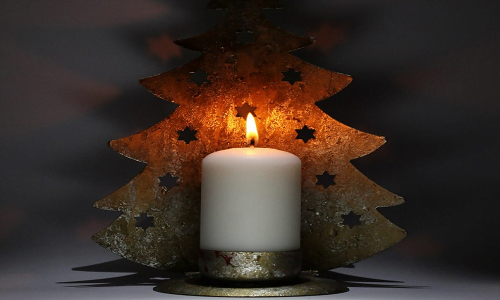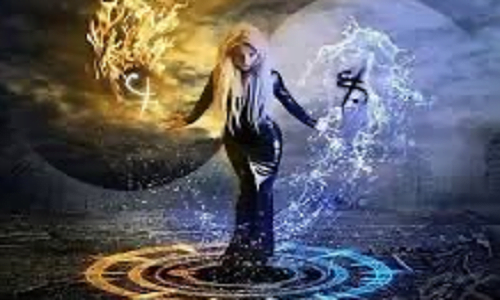Origins and Historical Context
Dziady (pronounced “JAH-dih”), meaning “Grandfathers” or “Forefathers,” stands as one of the most significant spiritual observances in the ancient Slavic pagan calendar. This ancestral feast of commemoration and veneration has its roots deeply embedded in the pre-Christian traditions of Belarus, Poland, Lithuania, and parts of Ukraine. While the celebration occurred multiple times throughout the year, the autumn Dziady, typically October 31st – November 1st, held particular significance as it coincided with the end of the harvest season and the beginning of the darker half of the year.
Traditional Rituals and Practices
Sacred Feast Preparation
The heart of Dziady centered around an elaborate ritual feast known as “uczta zaduszna” (feast for the souls), during which families would meticulously prepare specific foods and drinks full of symbolic significance. The feast typically included kutia (a sweet grain pudding), honey, bread, and vodka or mead. Hot dishes that produced steam were particularly important, as the steam was believed to provide sustenance for the visiting spirits. Families would set empty places at the table for their departed ancestors, creating a physical space for their presence during the celebration.
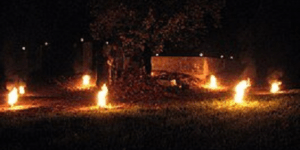
Ritual Elements
The preparation and execution of Dziady rituals followed strict protocols that were passed down through generations. Houses were thoroughly cleaned and purified with smoke from sacred herbs, particularly wormwood and juniper, believed to both attract beneficial ancestral spirits and ward off malevolent entities. Windows were left open to allow spirits entry, and fires were lit to guide ancestors home. Candles flickered in windows and at graves, creating a luminous pathway between the worlds of the living and the dead. Central to many regional celebrations was the use of the Karaboshka masks, carved wooden face coverings featuring distorted, often asymmetrical features that served multiple ritual purposes. These masks were believed to both protect the wearer from harmful spirits and facilitate communication with the ancestral world. The masks’ grotesque features were thought to frighten away evil spirits while simultaneously marking the wearer as existing between worlds during the ceremony.
The ritual feast itself followed precise ceremonial steps. Before any living person could eat, families would leave food offerings at graves and crossroads, prepare ritual baths for ancestral spirits, and recite specific prayers and invocations. The names of deceased family members were called out three times, moving from the oldest known ancestor to the most recently departed. Each name was accompanied by the ringing of a bell or striking of a wooden drum, its resonance believed to help guide the spirit home. In some regions, professional wailers were employed to lead these invocations, their trained voices carrying the names of the dead across the threshold between worlds.
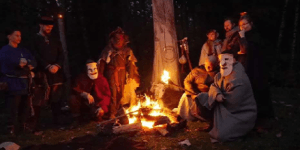
During the ceremony, certain actions were strictly prohibited to maintain the sacred nature of the space and protect both the living and the dead. No sweeping could occur during the feast, as it might symbolically sweep away the visiting spirits. Knives and sharp objects were removed from the table or covered, as they were thought to have the power to sever the connection between worlds. Participants were forbidden from sitting in doorways or thresholds, as these liminal spaces were reserved for the spirits’ passage. Looking directly into mirrors was prohibited during the ceremony, as they were considered portals that might trap unwary souls. The cutting of bread was replaced with breaking it by hand, and no one could leave the table before the ceremony’s conclusion without risking spiritual consequences.
Special ritual movements and gestures accompanied different parts of the celebration. Participants would perform a slow, counterclockwise circle dance called the Khorovod, linking hands to create a protective circle within which the ancestors could safely manifest. The wearing of embroidered ritual cloths called rushnyky, decorated with ancient symbols of protection and fertility, was mandatory for those leading the ceremonies. In some regions, participants would wear their clothes inside out as a way of symbolically inverting reality to match the inverse nature of the spirit world.
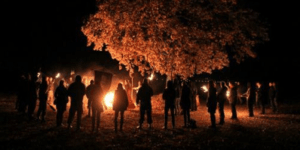
The ritual space was carefully constructed with symbolic elements. A central table or altar, called the ‘ancestor’s table,’ was positioned in the eastern corner of the home, traditionally considered the most sacred space. This table was covered with a white cloth and decorated with ears of wheat or rye, representing the harvest and abundance the ancestors helped provide. Ritual tools included a sacred bowl of water for spiritual cleansing, blessed salt for protection, and honey for sweetening the ancestors’ journey. In many regions, a special ritual bread called ‘Dziady bread’ was baked, marked with cross symbols and small holes through which the spirits could “taste” the offering.
Certain participants took on specific ritual roles during the ceremony. The eldest family member usually led the proceedings, acting as a bridge between the living and dead. A designated “rememberer” would be responsible for reciting the family lineage and significant events from the lives of the departed. Children were given special roles as message carriers between the living and the dead, as they were believed to be naturally closer to the spirit world. Young girls would often be tasked with maintaining the ritual fires, while young boys would ring the ceremonial bells.
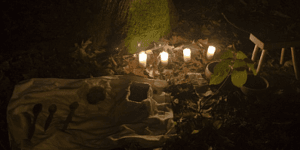
Symbolism and Spiritual Significance
Cosmological & Spiritual Understanding
The spiritual significance of Dziady was deeply rooted in the Slavic understanding of a three-tiered cosmos: Nav (the world of the dead), Yav (the physical world), and Prav (the world of divine law and order). The celebration served as a crucial bridge between these realms, facilitating communication and exchange between the living and their ancestors. In Slavic belief, ancestors were viewed as powerful protectors and guides for the living, requiring sustenance and care from their descendants. Proper veneration ensured good fortune and protection, while neglecting ancestral spirits could result in misfortune and hardship.
Symbolic Elements
The symbolic elements of Dziady were rich and multifaceted. Fire represented purification and transformation, while food served as physical sustenance transformed into spiritual nourishment. Crossroads were understood as sacred spaces where different worlds intersected, and the steam and smoke from ritual fires and hot foods created a tangible bridge between the physical and spiritual realms. These symbols worked together to create a powerful framework for understanding and experiencing the connection between the living and the dead.
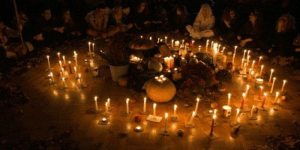
Modern Adaptations
Contemporary Practice
In modern times, Dziady continues to be observed through various adaptations that reflect both religious syncretism and cultural preservation efforts. The celebration has been integrated with Christian observances of All Saints’ Day and All Souls’ Day, while still maintaining many of its traditional elements. Contemporary celebrations often include church-sanctioned ceremonies at cemeteries, folk festivals, historical reenactments, and educational programs about traditional practices. A neo-pagan revival has also led to renewed interest in traditional ritual elements and modern interpretations of ancient practices.
Correlation with Samhain
The autumn celebration of Dziady shares remarkable similarities with the Celtic holiday of Samhain, reflecting common Indo-European roots. Both celebrations occur at the end of the harvest season and mark the beginning of the darker half of the year, when the veil between worlds is believed to be at its thinnest. The ritual practices of both traditions include fire ceremonies, feast preparation for the dead, the opening of doors and windows for spirits, and community gatherings. These parallels extend to spiritual beliefs about ancestor veneration, communication between worlds, protection from malevolent spirits, and the importance of proper ritual observance.

Conclusion
The enduring significance of Dziady lies in its ability to address fundamental human needs for connection, remembrance, and spiritual meaning. Whether practiced in its traditional form or through modern adaptations, the celebration continues to provide a framework for maintaining relationships with ancestors, marking the turning of seasons, and strengthening community bonds. The remarkable similarities between Dziady and Samhain highlight the universal human desire to maintain connections with the dead and honor the cyclical nature of existence. As contemporary society grapples with questions of mortality, heritage, and spiritual meaning, the ancient wisdom embodied in celebrations like Dziady offers valuable insights and practices for maintaining these essential connections to our ancestors and our roots.


